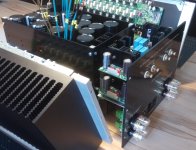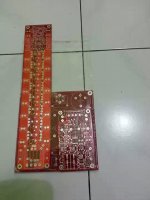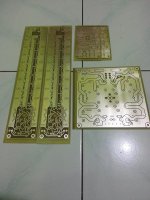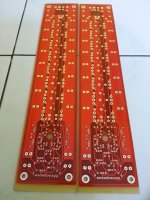I read what he writes in his books, not in diyaudio posts. I am not going to argue more about this topic.
I read what he writes in his books, not in diyaudio posts. I am not going to argue more about this topic.
OK, but that means he explains differently in his books and here on the forum. 😕
Amp in first post is "classical" three stage topology (dif. input, VAS , output stage)..Quote:
Originally Posted by kgrlee View Post
Don, IMHO, this amp is the best example of Self's 'Blameless' topology.
No it's not. According to Self blame is a three stage sch.
I know it's three stage, usually people stating two stages because of two voltage gain stages.
from post1098
statements:
a.)
this amp is the best example of Self's 'Blameless' topology.
b.)
No it's not.
c.)
According to Self blame is a three stage sch.
d.)
Please note that the Blameless configuration has three stages;
e.)
it is the Lin that has two.
Which statement is causing the problem?
What is the argument about?Quote:
Originally Posted by kgrlee View Post
Don, IMHO, this amp is the best example of Self's 'Blameless' topology.
No it's not. According to Self blame is a three stage sch.
Quote:
Originally Posted by DouglasSelf View Post
Please note that the Blameless configuration has three stages; it is the Lin that has two.
statements:
a.)
this amp is the best example of Self's 'Blameless' topology.
b.)
No it's not.
c.)
According to Self blame is a three stage sch.
d.)
Please note that the Blameless configuration has three stages;
e.)
it is the Lin that has two.
Which statement is causing the problem?
If I remember corectly, Douglas Self until 5th edition of his books, stated Blameless like a Lin 2 stages. In the latest book, 6th edition, he renamed it at 3 stages.
Hi Toni,
Awesome! Looks really nice and well thought out.
Btw. Where did you get the heat-sinks?
Mogens
Awesome! Looks really nice and well thought out.
Btw. Where did you get the heat-sinks?
Mogens
Hi Toni,
Awesome! Looks really nice and well thought out.
Btw. Where did you get the heat-sinks?
Mogens
Many thanks!
For heatsinks have a look at post # 951.
BR, Toni
2 donpetru,
... If an audioamp develop DC voltage at output, dependant on output power, it must horrible distort, and you should measure it and repair this fault... it is not inherent behavior of topology.😉
Small asymmetric distortions can generate small DC offset (additionally to "normal" DC offset). Its not need to be horrible 😉. I think that for example 0,1% second harmonic can generate few milivolts additional offset (depending on output power). It may be interesting way to measure such "special" kind of distortions - just using low pass filter and DC meter.
Toni, please forgive the basic question but what is the signal to noise ratio of this amplifier?
Toni, please forgive the basic question but what is the signal to noise ratio of this amplifier?
Voila:
- 20 µV - A-weighted
- 39µV - BW 20kHz
- 54µV - BW 80kHz
- 117µV - Full bandwidth (~ 500kHz limit of VP-7723)
- 125 db - A-weighted
- 121 db - BW 20kHz
- 117 db - BW 80kHz
- 111 db - Full bandwidth (~ 500kHz limit of VP-7723)
BR, Toni
Voila:
SNR in reference to 1kHz@200W@8R output level:
- 20 µV - A-weighted
- 39µV - BW 20kHz
- 54µV - BW 80kHz
- 117µV - Full bandwidth (~ 500kHz limit of VP-7723)
- 125 db - A-weighted
- 121 db - BW 20kHz
- 117 db - BW 80kHz
- 111 db - Full bandwidth (~ 500kHz limit of VP-7723)
BR, Toni
So unweighted is 111dB? Nice. Beats Theta's Citadel.
try upload...
Dear Boedy,
nice work. These pcb's have (hopefully) plated through holes?
It looks like the pcb's outline layer has been converted/merged to copper layers - maybe you need to cut the pcb's and remove the outline copper to avoid short circuits.
The bom list will take some days...
BR, Toni
Dear Boedy,
nice work. These pcb's have (hopefully) plated through holes?
It looks like the pcb's outline layer has been converted/merged to copper layers - maybe you need to cut the pcb's and remove the outline copper to avoid short circuits.
The bom list will take some days...
BR, Toni
thanks, i will try it..
Noise of audio amplifiers is usually measured with a 10Hz to 20kHz bandwidth.So unweighted is 111dB? Nice. Beats Theta's Citadel.
A weighting is often used.
So the two figures to use would be 121dB 10Hz to 20kHz
and 127dB A weighting.
But these are very exceptional, making me believe that the measurement bandwidths don't comply with the norm.
Attached picture from VP-7723D datasheet showing built in filters.
Maybe my fault: Is "PSOPHO A" the same as "A-weighted"?
Measured 125db not 127db. Do you mean 121 db "unweighted" should correspond with 127 db "A-weighted" otherwise the filters are not the correct ones?
BTW: the measurements are from lab setup where the cable routing was optimized. I hope but don't expect the same noise figures from the ready made amplifier - we will see soon...
BR, Toni
Maybe my fault: Is "PSOPHO A" the same as "A-weighted"?
Measured 125db not 127db. Do you mean 121 db "unweighted" should correspond with 127 db "A-weighted" otherwise the filters are not the correct ones?
BTW: the measurements are from lab setup where the cable routing was optimized. I hope but don't expect the same noise figures from the ready made amplifier - we will see soon...
BR, Toni
Attachments
Last edited:
- Home
- Amplifiers
- Solid State
- 2stageEF high performance class AB power amp / 200W8R / 400W4R






